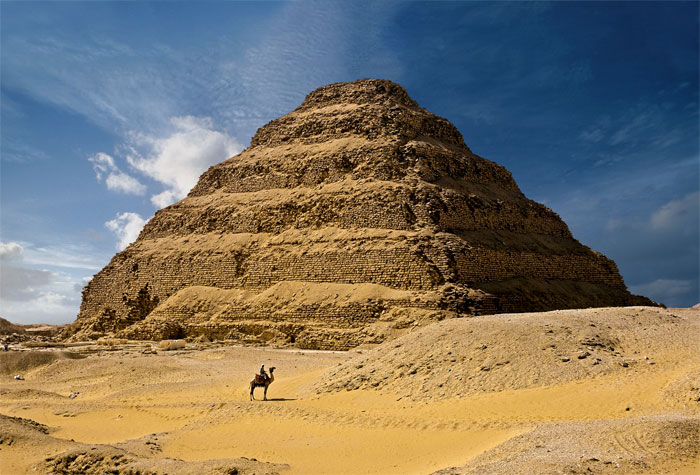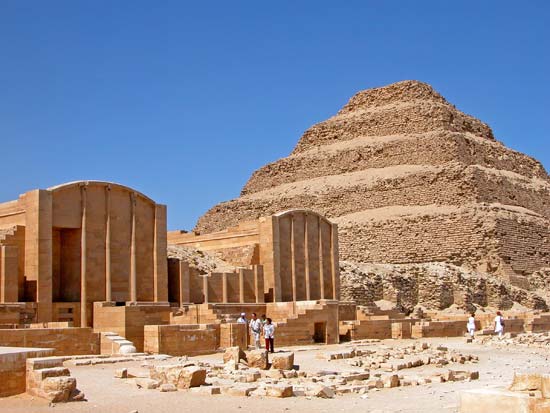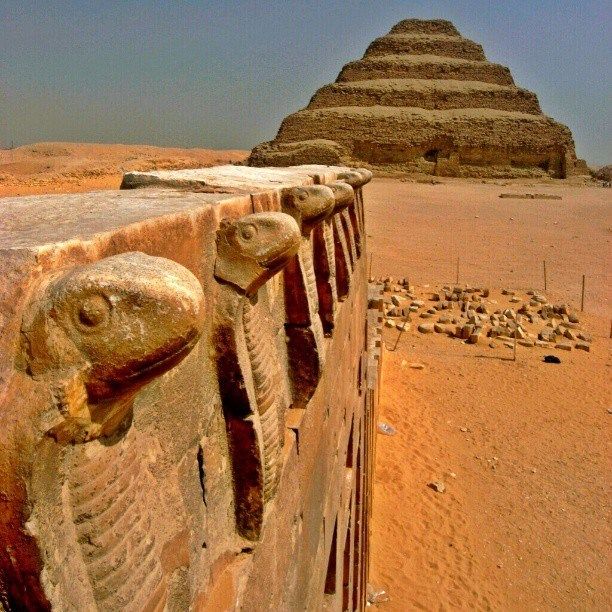The Pyramid of Djoser (or Djeser and Zoser), or step pyramid (kbhw-ntrw in Egyptian) is an archeological remain in the Saqqara necropolis, Egypt, northwest of the city of Memphis. It was built during the 27th century BC for the burial of Pharaoh Djoser by his vizier, Imhotep. It is the central feature of a vast mortuary complex in an enormous courtyard surrounded by ceremonial structures and decoration.
This first Egyptian pyramid consisted of six mastabas (of decreasing size) built atop one another in what were clearly revisions and developments of the original plan. The pyramid originally stood 62 metres (203 ft) tall, with a base of 109 m × 125 m (358 ft × 410 ft) and was clad in polished white limestone. The step pyramid (or proto-pyramid) is considered to be the earliest large-scale cut stone construction, although the pyramids at Caral in South America are contemporary and the nearby enclosure known as Gisr el-mudir would seem to predate the complex.
Djoser
Djoser was the first or second king of the 3rd Dynasty (ca. 2667 to 2648 BC) of the Egyptian Old Kingdom (ca. 2686 to 2125 BC). He is believed to have ruled for 19 years or, if the 19 years were biennial taxation years, 38 years. He reigned long enough to allow the grandiose plan for his pyramid to be realized in his lifetime.
Djoser is best known for his innovative tomb, which dominates the Saqqara landscape. In this tomb he is referred to by his Horus name Netjeriykhet; Djoser is a name given by New Kingdom visitors thousands of years later. Djoser’s step pyramid is astounding in its departure from previous architecture. It sets several important precedents, perhaps the most important of which is its status as the first monumental structure made of stone. The social implications of such a large and carefully sculpted stone structure are staggering. The process of building such a structure would be far more labor-intensive than previous monuments of mud-brick. This suggests that the state, and therefore the royal government had a new level of control of resources, both material and human. Also, from this point on, kings of the Old Kingdom are buried in the North, rather than at Abydos. Furthermore, although the plan of Djoser’s pyramid complex is different than later complexes, many elements persist and the step pyramid sets the stage for later pyramids of the 4th, 5th, and 6th Dynasties, including the great pyramids of Giza. Finally, another intriguing first is the identification of the architect Imhotep, who is credited with the design and construction of the complex.
Precedents
Djoser’s Pyramid draws ideas from several precedents. The most relevant precedent is found at Saqqara mastaba 3038. The substructure lay in a 4m deep rectangular pit, and had mudbrick walls rising to 6 m. Three sides were extended and built out to create eight shallow steps rising at an angle of 49°. This would have been an elongated step pyramid if the remaining side had not been left uncovered. In another parallel to Djoser’s complex, to complete this mastaba complex a niched enclosure wall was erected.
Pyramid substructure
Under the step pyramid is a labyrinth of tunneled chambers and galleries that total nearly 6 km in length and connect to a central shaft 7 m square and 28 m deep. These spaces provide room for the king’s burial, the burial of family members, and the storage of goods and offerings. The entrance to the 28 m shaft was built on the north side of the pyramid, a trend that would remain throughout the Old Kingdom. The sides of the underground passages are limestone inlaid with blue faience tile to replicate reed matting. These “palace façade” walls are further decorated by panels decorated in low relief that show the king participating in the Heb-sed. Together these chambers constitute the funerary apartment that mimicked the palace and would serve as the living place of the royal ka. On the east side of the pyramid eleven shafts 32 m deep were constructed and annexed to horizontal tunnels for the royal harem (The existence of this "harem" is debated). These were incorporated into the preexisting substructure as it expanded eastward. In the storerooms along here over 40,000 stone vessels were found, many of which predate Djoser. These would have served Djoser’s visceral needs in the afterlife. An extensive network of underground galleries was located to the north, west and south of the central burial chamber and crude horizontal magazines were carved into these.
Burial chamber
The burial chamber was a vault constructed of four courses of well-dressed granite. It had one opening, which was sealed with a 3.5 ton block after the burial. No body was recovered as the tomb had been extensively robbed. Lauer believes that a burial chamber of alabaster existed before the one of granite. He found interesting evidence of limestone blocks with five pointed stars in low relief that were likely on the ceiling, indicating the first occurrence of what would become a tradition. The king sought to associate himself with the eternal North Stars that never set so as to ensure his rebirth and eternity.
North Temple and Serdab Court
The northern (funerary/mortuary) temple was on the north side of the pyramid and faced the north stars, which the king wished to join in eternity. This structure provided a place in which the daily rituals and offerings to the dead could be performed, and was the cult center for the king. To the east of the temple is the serdab, which is a small enclosed structure that housed the ka statue. The king’s ka inhabited the ka statue in order to benefit from daily ceremonies like the opening of the mouth, a ceremony that allowed him to breathe and eat, and the burning of incense. He witnessed these ceremonies through two small eye holes cut in the north wall of the serdab. This temple appears on the north side of the pyramid throughout the Third Dynasty, as the king wishes to go north to become one of the eternal stars in the North Sky that never set. In the fourth Dynasty, when there is a religious shift to an emphasis on rebirth and eternity achieved through the sun, the temple is moved to the east side of the temple where the sun rises, so that through association the king may be reborn every day.
Heb-sed Court
The Heb-sed court is rectangular and parallel to the South Courtyard. It was meant to provide a space in which the king could perform the Heb-sed ritual in the afterlife. Flanking the east and west sides of the court are the remains of two groups of chapels, many of which are dummy buildings, of three different architectural styles. At the north and south ends there are three chapels with flat roves and no columns. The remaining chapels on the west side are decorated with fluted columns and capitals flanked by leaves. Each of the chapels has a sanctuary accessed by a roofless passage with walls that depict false doors and latches. Some of these buildings have niches for statues. Egyptologists believe that these buildings were related to the important double coronation of the king during the Heb-sed.












